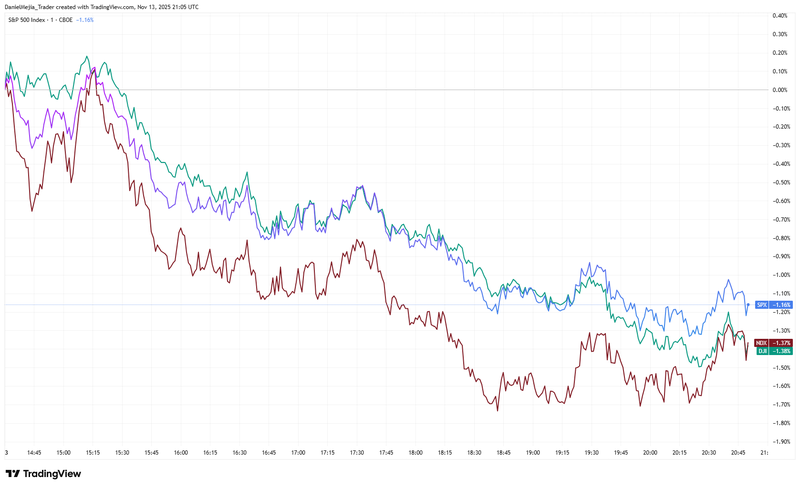Fed rate-cut odds drop: markets pull back
Hawkish commentary from several Federal Reserve officials prompted a marked repricing of policy expectations and a sharp correction in equity markets. The market-implied probability of a 25-basis-point cut at the December FOMC meeting fell significantly, and major US indices declined by more than 1.5 per cent.

Market pricing for a December 25-basis-point Fed cut has fallen to roughly 50 per cent following hawkish remarks from FOMC members, triggering a broad risk-off move.
Major US indices corrected sharply—Dow Jones Industrial Average, S&P 500 and Nasdaq-100 all lost ground—as investors digested the reduced probability of imminent easing.
UK third-quarter GDP slowed to 0.1 per cent quarter-on-quarter (1.3 per cent year-on-year), with manufacturing and extraction mining the principal drags on output.
Eurozone industrial production rose by 1.2 per cent year-on-year, below expectations, reinforcing concerns that activity remains subdued in key European economies.
Cut probability falls after Fed members’ hawkish tone
The CME Group’s FedWatch Tool now places the probability of a 25-basis-point cut at the December Federal Open Market Committee meeting at approximately 50 per cent. That decline in market-implied odds followed a series of public comments from FOMC officials expressing caution about the timing and scale of easing, and a reluctance among some members to move too quickly given persistent inflationary pressures.
Equity markets reacted swiftly: the Dow Jones Industrial Average fell 1.65 per cent to 47,457, the S&P 500 declined 1.66 per cent to 6,737, and the Nasdaq-100 lost 2.05 per cent to 24,993. The correction occurred even after the government shutdown ended and officials resumed routine reporting; investors are now awaiting the incoming flow of official economic statistics to reassess the committee’s likely path.

Figure 1. S&P 500, Nasdaq-100 and Dow Jones indices (daily performance). Source: Data from the Nasdaq Exchange and the NYSE Exchange. Figure obtained via TradingView.
UK gross domestic product comes in below estimates
The UK Office for National Statistics reported that third-quarter GDP expanded by just 0.1 per cent quarter-on-quarter, below consensus of 0.2 per cent and down from 0.3 per cent in the prior quarter. On a year-on-year basis, GDP growth slowed to 1.3 per cent, short of the forecast 1.4 per cent.
The productive sectors weakened: overall production growth eased from 0.8 per cent in the previous quarter to 0.5 per cent, with manufacturing contracting by 0.8 per cent and extraction mining by 1.5 per cent. The data are consistent with a muted growth profile: GDP has decelerated over recent quarters, unemployment remains elevated relative to recent years, and headline inflation persists above the Bank of England’s 2.0 per cent target (current headline inflation around 3.8 per cent).
Sterling nevertheless appreciated, rising c. 0.43 per cent against the US dollar to about USD 1.3189; part of that move reflected dollar weakness rather than a re-rating of UK growth prospects.
Industrial production in the European Union remains unchanged
Eurostat’s latest release showed that EU industrial production was unchanged on a year-on-year basis at 1.2 per cent, materially below the consensus expectation of c. 2.1 per cent. While not a contraction, the outturn suggests that industrial activity across the bloc remains lacklustre and that headwinds—notably in Germany—continue to weigh on manufacturing and related sectors.
The muted industrial-production reading underlines the broader theme of economic stagnation in parts of Europe, where weak domestic demand and external headwinds have constrained momentum. The euro appreciated c. 0.38 per cent to about USD 1.1635; as with sterling, currency moves were influenced in part by dollar dynamics as well as by local data.
